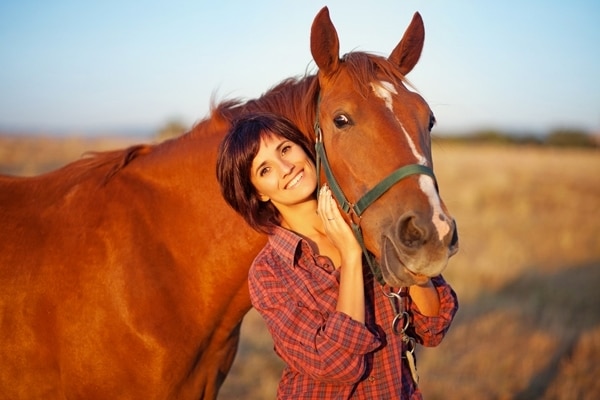By: Judith Freilich, MD
Recently, I had an opportunity to attend a Spirit Workshop at The Meadows. It was wonderful, and I want to tell you about it.
As a 74-year-old woman physician and psychiatrist, I probably am not the workshop’s typical attendee. My lack of experience with horses was equal to my fear of large beasts. But I still fully recall a horseback ride I took at my eighth-grade picnic when I was 14. It was a wonderful moment; the memory prompted me to say, “go for it!”
What is Somatic Equine Therapy and How Does it Work?
Somatic Equine Therapy is a type of therapy that combines somatic (body-centered) awareness with equine (horse-based) activities. It is a type of experiential therapy that uses the power of the relationship between horses and humans to help people heal from trauma.
The therapy involves activities such as grooming, horseback riding, and leading the horse, which help the person to become more aware of their body and emotions and to gain insight into how their trauma has affected their lives.
Through these activities, the person can learn to develop new coping skills, regulate emotions, and improve physical and mental well-being.
What Types of Trauma Does Somatic Equine Therapy Help Treat?
Somatic Equine Therapy is an effective treatment for various trauma-related conditions, including PTSD, anxiety, depression, and more. It has been shown to be especially helpful in cases of emotional and physical trauma stemming from abuse and neglect, as it provides an opportunity to build trust and connection with an animal.
Additionally, somatic equine therapy can be used to help those who have experienced life-altering events such as accidents, natural disasters, and military combat. This type of therapy can also benefit those dealing with childhood emotional issues, such as abandonment or bullying. Through the use of physical and emotional connection with a horse, Somatic Equine Therapy can provide a safe and supportive environment for addressing and healing trauma.
What are the Benefits of Somatic Equine Therapy Compared to Other Types of Therapy?
The key benefit of Somatic Equine Therapy compared to other types of therapy is the use of the horse as a therapeutic tool. The horse provides a non-judgmental and calming presence, allowing the individual to focus on the healing process.
Additionally, the physical connection between the horse and the individual can help to create a stronger bond, allowing the individual to access feelings that they may not be able to access in other forms of therapy.
Releasing Trauma Through Somatic Experiencing®
On the appointed morning, I showed up at Buddy’s ranch without cowgirl clothes —no fun hat, boots, or jeans—for a 5-day, equine-assisted, somatic experience® (SE) workshop. What I did bring with me was a history of profound trauma that began at a very young age. I also arrived with positive, hopeful feelings about SE and its ability to help me release old trauma.
I was not a stranger to myself becauce I had worked diligently in all kinds of therapies for decades. I’d explored healing modalities far afield from my training and practice in western medicine and psychiatry. I’ve experienced and studied bodywork and energy work in many forms. I have a strong faith and spiritual sense that had kept me alive and caring for others well in the face of my own immense loss and trauma.
These modalities were all helpful; I have no doubt they kept me functioning and fairly healthy. But, although layers of trauma had been peeled back through this work, there was still trauma frozen in my nervous system and body.
I viewed my remaining trauma as a huge iceberg, all of it intertwined in ways that made it difficult to tease out any one issue without flooding the whole system. I had not yet experienced trauma work through The Meadows.
Tips for Getting the Most out of Somatic Equine Therapy?
When seeking Somatic Equine Therapy, it is important to remember that it’s a process, not a quick fix. The best way to get the most out of it is to be open and honest with your therapist and actively participate in the therapy.
It’s also important to be mindful of your body and emotions during the sessions. It’s best to arrive for the sessions relaxed and ready to focus. Having realistic expectations is also beneficial, as results may not appear immediately.
Finally, it’s important to trust the process and give it time to work.
Finding the Right Horse
Yet the horse knows the way, as the old song goes, especially if the horse has wise steerage by Colleen DeRango and Buddy Uldrikson. These two gifted human beings are trained in Somatic Experiencing® and in horsemanship─ deeply trained. I trusted them from the start. When Colleen and Buddy saw my trauma list, they were surprised but not daunted. They said the horse would know the way.
And they were right! There were five of us in the workshop, and we formed a cohesive group of support. On the first day, it poured chilly rain. We were asked to walk past all the horses in their stalls and find one we connected with. We were to sense each horse’s response to us and ours to them. This seemed impossible to me!
I walked the line of 12-15 stalls three times, mostly scared and bewildered. I did not feel a sense of connection with any horse. At the far end of the third pass, I approached a huge horse, one that had already turned its butt to me the other two times I’d passed by. That I did feel!
As I approached him this time, he turned his face toward me as a huge tear came out of his right eye. He put his head through the fence gate, sniffed at me, and nuzzled me. I felt his warm breath, and I felt warmer. To my surprise, I instantly felt grounded. And a huge, healing breath went all the way through my body, naturally!
My energy had re-aligned itself in the presence of this beautiful, soft-eyed horse. He was very tall, the largest horse there. He was a rich brown with a black mane and tail, a white line on his face, and white on his lower legs─ it looked like he had on knee-high socks. His breed is German Warmblood, with a fine pedigree:
- He wasn’t getting along with the other horses so he was alone in a pen
- He was expected to become a fine jumper
- He was at Buddy’s ranch for some training
And I fell in love! We called him Jumper. As Jumper and I worked together through the week, our bond grew. Everyone could feel it. Jumper was calm and extraordinarily gentle with me, which was more than I could have imagined.
The Healing Process
As I drove to Buddy’s ranch daily, I felt stronger and better. As soon as my car got onto the ranch, I relaxed and loved every moment there. To me, the land at the ranch has a sacred quality. The horses add their presence. I loved the sounds and smells, the earth and sky, and the old mesquite tree we sat under each morning to check in and meditate. And all around us was the snuffling of these wonderful beings.
I learned that research done by the Heart Math Institute in California shows that the heart energy field of a horse is nine times larger than our human heart energy fields. I believe it! Under Colleen and Buddy’s expert guidance and in Jumper’s warmth, a huge piece of frozenness left me. I felt it go! And no flooding…
I was not the only one to notice. One evening that week, I went into Phoenix to see the cranial-sacral osteopath who has treated me off and on for almost 10 years, ever since I broke a leg. My whole system was locked in a ‘freeze’ from shock back then. It was not simply shock from the fall that broke my leg; it was a deeper shock that went all the way back to a tragedy more than 20 years earlier. She has treated me throughout all the other good work I have done for myself for years.
She put her hands gently on my head. Almost immediately, she said that whatever I was doing was making a remarkable change in my nervous system, more so than anything I had done to date. No question. Change, even partway through the Spirit Workshop, was already palpable. That change has been maintained and has even deepened since.
Since the workshop ended, I have been able to continue working with Colleen and Buddy. (I live nearby.) Jumper had to go back to his owner, and we parted lovingly. I am fond, very fond, of the other horses, but a first love is always a first love!
Buddy’s ranch is still a special place for me. I have a cowboy hat and jeans; I’m working toward boots. I continue to see the docs taking care of me. They continue to see progress in healing my nervous system at a deep level.
I am grateful!
How to Find a Qualified Practitioner?
Start by researching qualified therapy centers and speaking to your primary care physician or mental health professional for referrals. Ask potential practitioners about their experience with Somatic Equine Therapy, their qualifications, and the scope of their practice.
Always check their credentials and ensure they are certified in the therapy they offer. Finally, make sure to schedule a consultation with the practitioner to discuss your individual needs and ensure that they can provide the best treatment for your situation.
Register for Spirit: A Somatic Equine Workshop
The Spirit workshop has a 5-day and a 3-day option. Register today, as spaces are limited.



